| |

Hello! I feel like I am getting to know many of you from your emails and participation in the live chats. I'm excited to share with you another day of adventures. Today, I'll tell you about weather and typhoons, Micronesian involvement in World War II (WWII), Operation Hailstone, our visits to WWII monuments, and, on a lighter note, my own personal crusade to find out about the many junked cars in Chuuk.
Before I start, I have a special request. For those of you that didn't catch this on our chat yesterday, I am thinking of organizing a book drive for Saramen Chuuk Academy to increase their library collection. Anyone who wants to help, please email us at adventure@iamcopernicus.com.
Also, thanks to all of you who sent your gift suggestions for Elvis and Lealoha Sharai, who arranged our visit with the school. We followed your suggestion about giving them something from where we live and gave them T-shirts from our home state of Colorado.
Weather and Typhoons
Remember how I told you all about the beautiful weather in Chuuk? Well, all day today, it rained sporadically. At first the rain wasn't very hard, but then it started pouring and didn't let up for about four hours. In fact, the rain poured down so hard that the electricity in our hotel room flickered on and off. I'm not used to this kind of heavy rain because at home, in Colorado, it only rains about 14 inches per year total. Here, it seems to have rained half that amount in one day and nobody seems to think it is a big deal. I learned that collecting rainwater from the roof is one way to get fresh drinking water here if you are in a remote area. That wouldn't get you far where we live!
One reason no one in Chuuk seems concerned about the rain is because this is the rainy season. The locals call it "winter" but that is a relative term; having come here from the Colorado mountains, I can't even imagine a winter where it is 90° F every day. Does that mean it gets even hotter here other times of the year?
We asked our fearless boat captain, Estos, about typhoons. A typhoon is a storm very similar to a hurricane, but it is called a typhoon when it occurs in the Pacific Ocean. We have heard so much about hurricanes in the U.S. in last few weeks that we were glad when Estos told us that typhoons are relatively rare in Chuuk. Estos said the last typhoon hit the region in the 1980s and that there have only been three in the last 30 years that hit Chuuk.
(Click on any photo to enlarge it.)
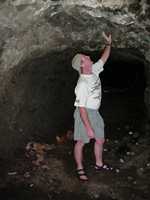 When a typhoon is approaching, the Chuukese hear about it from the local radio station. They then begin to prepare for the storm. If they live in a house made of concrete with a metal roof, they board up the windows and stay in the house, which is similar to how we prepare for hurricanes in the U.S. People who live very close to the coast evacuate to higher ground. Locals who live in thatch-roof huts (as many of the outer islanders do) retreat to a cave in the mountains to wait out the storm. There are many caves, both natural and ones carved out of the hills by the Japanese during the war. We visited one such cave today.
When a typhoon is approaching, the Chuukese hear about it from the local radio station. They then begin to prepare for the storm. If they live in a house made of concrete with a metal roof, they board up the windows and stay in the house, which is similar to how we prepare for hurricanes in the U.S. People who live very close to the coast evacuate to higher ground. Locals who live in thatch-roof huts (as many of the outer islanders do) retreat to a cave in the mountains to wait out the storm. There are many caves, both natural and ones carved out of the hills by the Japanese during the war. We visited one such cave today.
Micronesian Involvement in WWII
Before I start telling you about the reminders of WWII we saw today, I want to give you some background about the important roles that the Micronesian islands, Chuuk, and Chuuk Lagoon played in the Pacific Theater fighting of WWII.
The war in the Pacific began on December 7, 1941 when Japan bombed American bases in Pearl Harbor, Hawaii and in Guam. The Japanese attack on Guam caught the U.S. off guard and Guam fell to the Japanese two days later. With this victory, Japan secured complete control over all of Micronesia.
To guard their Pacific possessions, the Japanese transformed Chuuk into their main central Pacific naval base. From Chuuk, the Japanese forces were in an excellent position to launch attacks. Chuuk's deep lagoon, high islands, and circling barrier reef provided extensive natural protection. To build up this natural protection even more, the Japanese built five airfields with close to 500 aircraft. Patrol boats, torpedo boats, submarines, tugs, landing craft, gunboats, and minesweepers served as another layer of defense.
On Chuuk, the Japanese also built facilities to churn out arms and equipment for a wide military blitz over the Western Pacific. Often more than 1,000 merchant and war ships were moored in the Chuuk Lagoon, ready for immediate departure if necessary
It wasn't until 3 years after the Pacific War began that the U.S. started to fight back with vigor. Beginning February 1, U.S. Admiral Chester Nimitz, Commander in Chief of the Pacific Fleet, attacked Japanese bases in the Pacific. After several other victories, the Admiral set his sights on Chuuk Lagoon.
Because Chuuk seemed so shielded, the Japanese command may have became overconfident and relaxed their guard against fast-approaching U.S. forces. Before they attacked, the U.S. military weakened the Japanese troops in Chuuk, by cutting off supplies to the island and depriving troops of food, fuel, and arms. Then, in early 1944, the U.S. launched "Operation Hailstone."
Operation Hailstone
"Operation Hailstone" took place February 16-18, 1944. A huge armada of carriers, battleships, cruisers, destroyers, and submarines bombarded Chuuk Lagoon. Operation Hailstone was one of the most damaging attacks in history. It cost the Japanese 250 planes, 60 vessels, and thousands of lives. A follow-up attack in April 1944 finished off the base at Chuuk. The U.S. took over the island and moved the administrative center from Dublon to Weno (called Moen at the time), where it remains to this day.
After Operation Hailstone, the U.S. attacked other Japanese bases in the region. In June 1944, the U.S. began fighting for Saipan, Guam, and Tinian. After much bloodshed, the U.S. managed to win these islands. These Pacific victories were a turning point in the war because they allowed U.S. troops to establish bases close enough to Japan to be in striking distance.
The U.S. began air strikes on Japan from their new bases in Micronesia. On August 6 and 9, 1945 U.S. planes took off from the Micronesian island of Tinian. These planes dropped atomic bombs on the Japanese cities of Hiroshima and Nagasaki. This was the first and only time atomic weapons were used in war. A few days later Japan surrendered, hastening the end of WWII.
WWII History in Weno
Having read a lot about the Chuuk's role in WWII, I was anxious to go and see some of the reminders of the war around the island. This afternoon we went to see the Japanese War Memorial and a huge gun above the village.
There is a large cave about a mile into the interior of the island from the harbor. Called Nefo Cave, it was tunneled out by the Japanese, who forced the Chuukese and people from occupied China to help. The cave has four entries and is tall enough to stand in. It looks more like a tunnel than a cave.
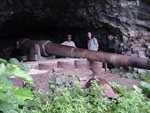 The side that faces the harbor has a large gun pointed over the lagoon. Though the gun seems to be positioned far away from the water, it fired large shells that could reach all the way into Chuuk Lagoon, over a mile away. We saw some of these large shells on a wreck yesterday. Guns placed in caves like this provided the Japanese with a good way to protect their military base on the island during WWII. Standing on this spot, I could easily imagine that there were once Japanese soldiers stationed here, sleeping in the cave and taking shifts to watch for approaching ships.
The side that faces the harbor has a large gun pointed over the lagoon. Though the gun seems to be positioned far away from the water, it fired large shells that could reach all the way into Chuuk Lagoon, over a mile away. We saw some of these large shells on a wreck yesterday. Guns placed in caves like this provided the Japanese with a good way to protect their military base on the island during WWII. Standing on this spot, I could easily imagine that there were once Japanese soldiers stationed here, sleeping in the cave and taking shifts to watch for approaching ships.
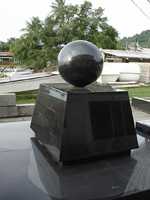 After viewing the gun, we headed back into town to visit the Japanese War Memorial. The Japanese government erected it in 1980 to commemorate the lives lost in Chuuk during the war. It is situated right in the middle of the village, overlooking the harbor. The inscription reads as follows, in English and Japanese:
After viewing the gun, we headed back into town to visit the Japanese War Memorial. The Japanese government erected it in 1980 to commemorate the lives lost in Chuuk during the war. It is situated right in the middle of the village, overlooking the harbor. The inscription reads as follows, in English and Japanese:
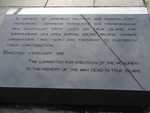 "In memory of Japanese military and paramilitary personnel, Japanese residents and Micronesians who sacrificed their lives on Truk Island and the surrounding sea area during South Pacific combat operations (1941 - 1945) and transmit to posterity their contribution.
"In memory of Japanese military and paramilitary personnel, Japanese residents and Micronesians who sacrificed their lives on Truk Island and the surrounding sea area during South Pacific combat operations (1941 - 1945) and transmit to posterity their contribution.
Erected: February 1980 by the Committee for Erection of the Monument to the war dead in Truk Island."
Junked Cars
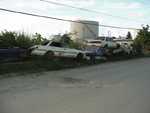 Driving around Chuuk the past couple of days, Tom and I have noticed a lot of junked cars left along the sides of the road. I must admit I became really interested in finding out why there were so many abandoned cars, so I set out to get the scoop.
Driving around Chuuk the past couple of days, Tom and I have noticed a lot of junked cars left along the sides of the road. I must admit I became really interested in finding out why there were so many abandoned cars, so I set out to get the scoop.
At first I thought the cars might be on the sides of the road because there was just nowhere to put the cars. I thought, "Maybe they don't have a junkyard because there isn't enough land (it's not that big of an island)." Well, I was correct about there being no junkyard on the island. The junkyard is in the ocean and you have to reach it by boat! In fact, there is a special, assigned place away from the islands to dump cars. Tom says that years from now the junkyard of cars will turn into a reef, in the same way that the sunken wrecks have become beautiful tropical reefs.
But back to my original question: "Why are the junked cars on the sides of the road?" It took a bit more investigation but here is what I learned. The real reason for all the junked cars along the road is that their owners consider them valuable property and don't want to part with them. They salvage spare auto parts as well as scrap metal as needed. Everything is reused and recycled. Not much is considered waste here, and even what we think of as junk has its value.
Tomorrow is our last full day on the island; we plan to have dinner with a family on the outer islands, and will post our journals on Monday. Then stay tuned for our visit to Pearl Harbor.
Have a good day,
Karen
|


